Having smaller hands should never be a barrier to a comfortable guitar-playing experience, no matter what genres of music you prefer. In years gone by, many guitarists had to make do with uncomfortable guitars that hindered progress and then frustration from the lack of progress, resulting in players simply quitting.
So if you’re looking to find a guitar that’s better suited to smaller hands, you’re in the right place. In this KillerGuitarRigs Guide, we’ll be reviewing the best guitars for players with smaller hands across three categories – electric, acoustic, and classical.
During each test we were looking primarily at comfort for players with small hands, with overall ergonomics being a factor, too. Of course, the quality of the instrument and its tone were also a big part of our test. For consistency, the electric guitars were both played through a Monoprice Stage Right 5w tube amp.
Read more about our review process.
Individual Reviews
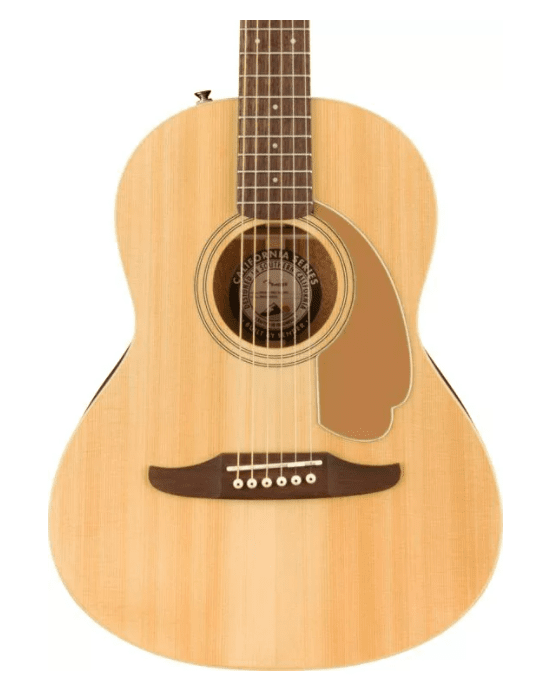
Fender Sonoran Mini
Great components and peerless style priced to suit any budget
A fantastic acoustic guitar that works as well as a primary instrument as it does for travel. It’s compact, looks great, and offers excellent playability.
The Fender Sonoran Mini has become a fast favorite in the relatively short time since its release, and it’s not hard to see why. For an absolute bargain price, Fender have come up with a great-looking, reduced-scale guitar that is ideal for the smaller-handed player.
The neck is one of the smallest we’ve tested at KGR, with a nut width of just 1.615”. This made it very easy to get fingers wrapped around into barre chord patterns, which is something players with small hands tend to struggle with most on full-size and wide-necked guitars.
The Sonoran has a Fender “Modern C” neck profile, which is one of their shallower styles. It’s ideal for getting a neutral grip on the neck, which will keep your hand more comfortable for longer.
It also features a reduced scale length (24.1”), which was extremely comfortable. Not only did this make stretching out for chords and runs easier, but it resulted in lower string tension, which made depressing notes much easier than on the majority of acoustic guitars.
Looks-wise, this guitar is an absolute winner. We loved the caramel pickguard on the solid spruce top. It’s such a different combination and it brings a great retro feel. Adding to the retro aesthetic are the vintage-style tuning pegs, which suit this guitar perfectly. The spruce top had a nice grain to it, and it was nicely complemented by the bound mahogany back and sides, and the Nato neck. It comes with a Stratocaster-style headstock, which we always think looks great on acoustic models.
Tonally speaking, the Sonoran was bright and snappy, features typical of spruce-topped guitars. It also had a depth of sound that isn’t overly common on reduced-scale models, this was probably the biggest surprise this guitar had in store for us.
The gig bag that was bundled with this guitar was a nice bonus. We don’t always expect to get a gig bag at this price point, so while it isn’t the most luxurious case, the fact that it came with one at all was still great.
Verdict: The Fender Sonoran Mini is a solid choice for guitarists with smaller hands. The neck was comfortable and the short scale length suited it well. The smaller body makes it comfortable for kids as well as adults. It’s well-built and Fender has chosen some quality woods and components, resulting in a guitar that far outperforms its low price point.

Martin D Jr-10E
Legendary Martin sound and presence, scaled down to suit smaller hands
This comfortable Martin strikes a balance between booming presence when strummed hard and a delicate intricacy when played with a softer touch.
Martin is one of the oldest names in the guitar business. With so much experience, it’s not hard to understand why the Martin D Jr-10E made it onto our list of top guitars for small hands. With their vast experience, Martin has crafted a true dreadnought guitar that is actually comfortable for smaller-handed guitarists, which in and of itself is rare.
We found it to be extremely comfortable right out of the box. The nut width was among the widest of any of the models we tested at 1.75”, but the neck profile is a Martin Performance Taper, which compensated well for that. We were able to comfortably grip the neck, and barre chords were easy to play up and down the fretboard.
Also helping playability for guitarists with small hands was the short scale, which measured in at 24”. This reduced length made it easy to stretch out for chords, and kept us comfortable during extended scales practice sessions. At 15/16th, the body feels similar to a full-size model, but thanks to the slim neck and shorter scale, it’s much more comfortable.
Being a Martin, you’re getting exactly what you’d expect as far as quality is concerned. Fit and finish were superb – far beyond what the majority of instruments at this price point. The top is solid Sitka spruce, and the back and sides are sapele. Both are basic, but high-quality tone woods that lend a great bite to the tone, keeping things bright without ever sounding shrill.
The overall presence of the sound was classic Martin, with a big midrange and plenty of punch. It did lose out a little bit when it comes to volume when compared to a full-size guitar, but that’s to be expected. It didn’t detract from the sound and if you truly need the guitar to be louder, you can plug into an amp, thanks to the built-in Fishman Sonitone pickups and electronics. When plugged in, the D Jr-10E still kept its punch without losing any of its acoustic character, so we’ve no doubt it would be a great companion for gigging.
This is by no means a cheap guitar, but it’s far from expensive in the scheme of things with acoustic guitars. So to get a high-quality hybrid gig bag/hard case as we did with this model was fantastic. It’s sturdy enough to deal with transport and storage, perfect for keeping your new Martin in pristine condition.
Verdict: The Martin D Jr-10E is the perfect starting point into the Martin brand if you’re yet to own one of these wonderful guitars. The neck has great ergonomics and felt comfortable enough to play all day without fatigue. You’ll get high-end components and genuine Martin tones, a recipe for a great-sounding guitar that will last a lifetime.
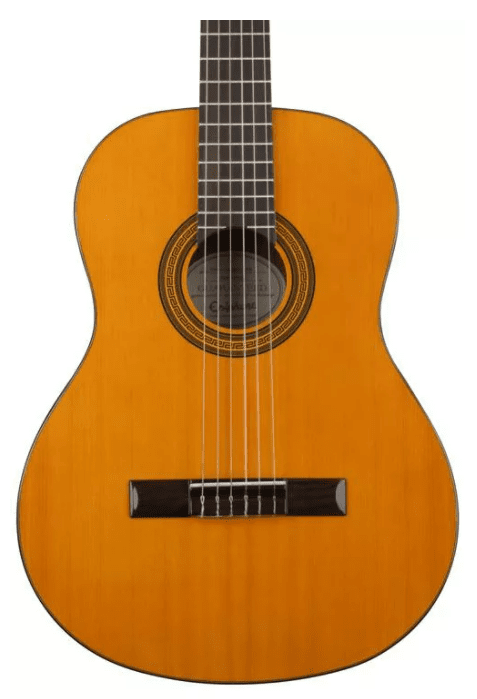
Epiphone PRO-1 Classic ¾ Size
Classic looks and great tones from a well known brand
A true classical with a contemporary twist. This guitar comes with the winning combination of a neck that’s suitable for players with smaller hands, and the quality assurance that comes from a well known brand.
The Epiphone PRO-1 Classic is a phenomenal choice for players with smaller hands looking to get into their first classical guitar. Epiphone isn’t necessarily the first name people think of when it comes to classical instruments, but when it comes to high quality and great value guitars for beginners, it’s one of the go-to brands.
Unlike steel string acoustics, classical guitars almost always conform to a uniform 2” nut width, which for the majority of players with small hands is prohibitively wide. This Epiphone, however, breaks that rule with a relatively slim 1.89” nut width. The difference in comparison to a full-size classical guitar was extremely noticeable. We were able to play much more smoothly than we thought was possible.
It has an Epiphone D profile neck, which is nice and shallow, and again comfortable for extended use. The body is a ¾-size, making it a comfortable choice for kids and smaller adults alike, and the scale length is very short at just 22.8”, which made fast runs up and down the neck really easy to play.
Despite breaking from tradition when it comes to nut width, almost everything else about this Epiphone is pretty standard for a classical guitar. It’s made with a cedar top and mahogany back, sides, and neck. The resulting tone was warm and surprisingly rich for such a small guitar. It had a lot of bite and considering the extremely low price, sounded excellent. We liked the rosette design and found that the binding was well applied.
Another nice touch on this guitar was the inclusion of top and bottom strap buttons. Many classical guitars have no means of attaching a strap, but as many beginners rely on them for support, it’s great to have the option.
Verdict: Overall, the Epiphone PRO-1 Classic was a great guitar that we felt performed as well as instruments twice its price. It looks great and thanks to the slim neck and narrow nut, it was extremely comfortable, with chords easily reached despite the wide string spacing. It’s a well-appointed guitar for the money, and will serve well a player with small hands looking to learn on a classical guitar.
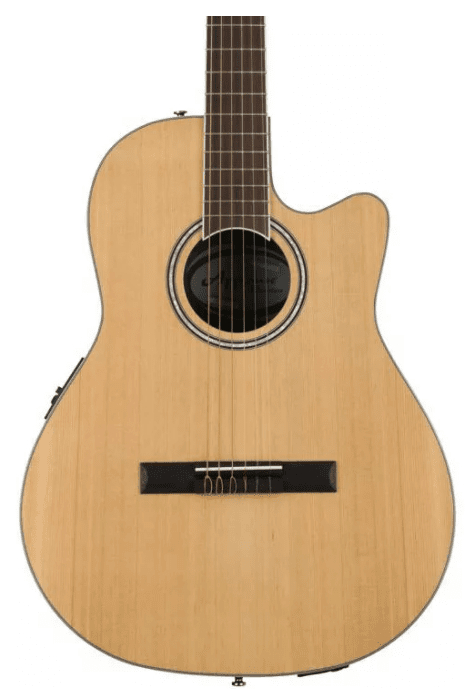
Ovation Applause AB24CC-4S
Bridging the gap between classical and modern with comfort for smaller hands in mind
You can amplify your classical tones to the masses with this electric-acoustic Ovation, a guitar that breaks from tradition and brings nylon strings into the 21sst century.
Ovation guitars were revolutionary when they first appeared, with their composite bowl backs, onboard pickups and built-in preamps. These are words you don’t often hear in conversations about classical guitars, but the Ovation Applause AB24CC really works.
Like the Epiphone we tested, the Ovation has a nontraditional nut width, coming in at 1.889”. That may seem like a marginal difference, but again it makes a massive difference from a full-width 2” nut. We were easily able to wrap our hands around the C-shape neck and we found it to be easy-playing and comfortable.
Another steel-string crossover with this guitar is the cutaway on the treble bout. It gave us great access to the higher frets. The kind of access players with smaller hand simply don’t get with a traditional guitar.
The body is full-size, but the back is a medium bowl shape, which gave excellent ergonomics. The bowl is a special polycarbonate material, which holds up to impact, moisture, and almost any other rigor in a way wood never could. For this reason alone, it’s a great road guitar.
To keep the tones correct, it’s made with a cedar top. We found it to be very sweet sounding, with great projection from the Lyrachord bowl.
The biggest selling point for the Ovation, however, is the quality of the pickups and preamp. This isn’t an afterthought, as Ovation’s entire model is based on semi-acoustic instruments. There’s a piezo pickup underneath the saddle and the CE304T preamp even comes with 3-band EQ. We were easily able to shape our sound when plugged in. Getting that kind of tonal variety from a classical guitar is almost unheard of. Best of all, there’s a tuner built into the preamp too, which we found to be as accurate as any clip-on tuner you could buy.
Verdict: If you’re transitioning over from a steel string to a classical, the Ovation Applause AB24CC-4S is a great option for you. Even if it’s your first 6-string instrument, you’ll find it comfortable and easy to play. The electronics are user friendly and the hard-wearing back and sides will take more punishment than the average classical guitar ever could.
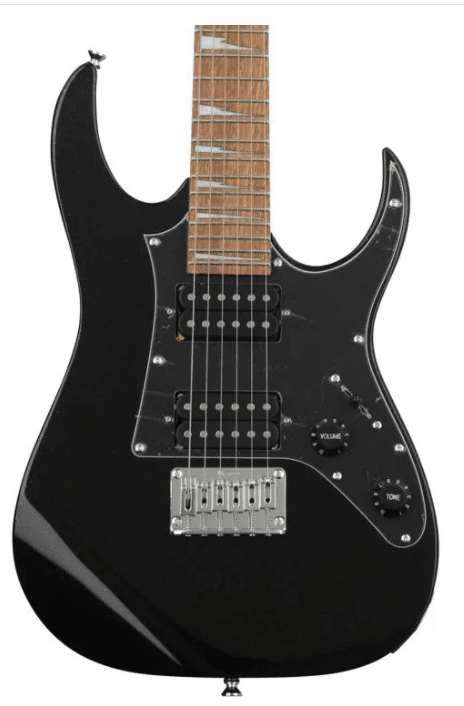
Ibanez Mikro GRGM21
A fast playing electric that’s comfortable for players of all ages
The perfect option for guitarists with smaller hands who want metal aesthetics and lightning fast playability.
The Ibanez Mikro GRGM21 has been a super popular first guitar for some time now, but what makes it a good choice for beginners also lends itself to players with smaller hands. Despite the scaled-down size and low price, it’s still a very well spec’d guitar. So opting for this Ibanez doesn’t result in any sacrifice.
The neck is one of the most notable features with the Mikro. It gets an Ibanez GRGM, which is a slim D profile, only marginally thicker than the famous Ibanez Wizard necks. We found it to be lightning fast playing, and probably the most comfortable of all the guitars we tested.
The body is a reduced size, which makes it comfortable for younger players (thus the popularity of 1/2-sized guitars) and we didn’t feel it was detrimental to comfort for adult players, either. The scale length is short at just 22.2”, but that really did help when it came to running through scales and stretching for barre chords, too.
Basswood is the tone wood of choice in the body. It isn’t an exotic choice, but considering it’s also used on much more expensive guitars, you’re getting real value here. The pickup setup has a humbucker at the neck and one at the bridge, with a single coil in the middle. We got some really chunky high-gain tones out of this guitar and the bridge pickup was surprisingly good. It does have a hardtail bridge, so you’ll have to look elsewhere if you were looking for an Ibanez with a tremolo arm.
Verdict: An Ibanez Mikro GRGM21 is a great choice for young players and adults with smaller hands, alike. It has aggressive looks, great tones, and the neck is unbelievably well-suited to those who find thick necks uncomfortable. For less than $200, you’re getting a lot of guitar.
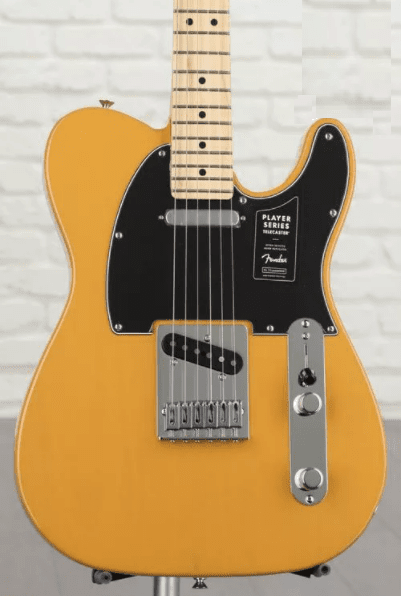
Fender Player Telecaster
An easy playing, comfortable guitar with timeless looks
A classic choice reimagined for guitarists with smaller hands. The Player series has a slimmed down neck compared to the standard models, making it a much more comfortable proposition.
The Fender Player Telecaster is the entry point when it comes to Fender branded Teles, and it also happens to be packed with features that make it ideal for guitarists with smaller hands. Because it has a full-size body, it’s particularly appealing to adults with smaller hands who don’t necessarily want a reduced scale or compressed body.
This Telecaster has a nut width of just 1.650”, which is pretty tiny in the world of full-sized guitars. This made it extremely comfortable to grip and to move around the fretboard. It features a Fender Modern C neck profile, which is actually an asymmetrical design. The ergonomics provided by this neck design were great for reducing fatigue, and they really helped to improve barre chord form.
It’s a full-size, full-thickness Telecaster, unlike the Squier models, but the design made it nice to hold. The action was nice and low, too, so there wasn’t a lot of effort required to depress the strings. This also helped to improve comfort and playability.
Our test model was in Butterscotch Blonde with a maple neck, which many consider to be the signature look for Telecasters. The paint finish was superb, and the overall build quality was about the best we saw from any of the guitars on test, perhaps with the exception of the Martin D JR-10E.
The tone profile was everything you’d expect from a Telecaster, bright and chimey with the classic Tele spank and twang from the bridge pickup. The setup is 2 single-coil alnico pickups with a 3-way selector switch with a single volume and a single tone control. The pots are full-size and operated with a wonderful swell and no noticeable dropoff.
Verdict: If like many others, you’ve struggled to find a full-size guitar aimed at intermediate and above players that is suitable for smaller hands, the Fender Player Telecaster may well be the guitar you’ve been searching for. It has a super slim nut, an extremely comfortable neck, and a hugely dynamic tone profile.
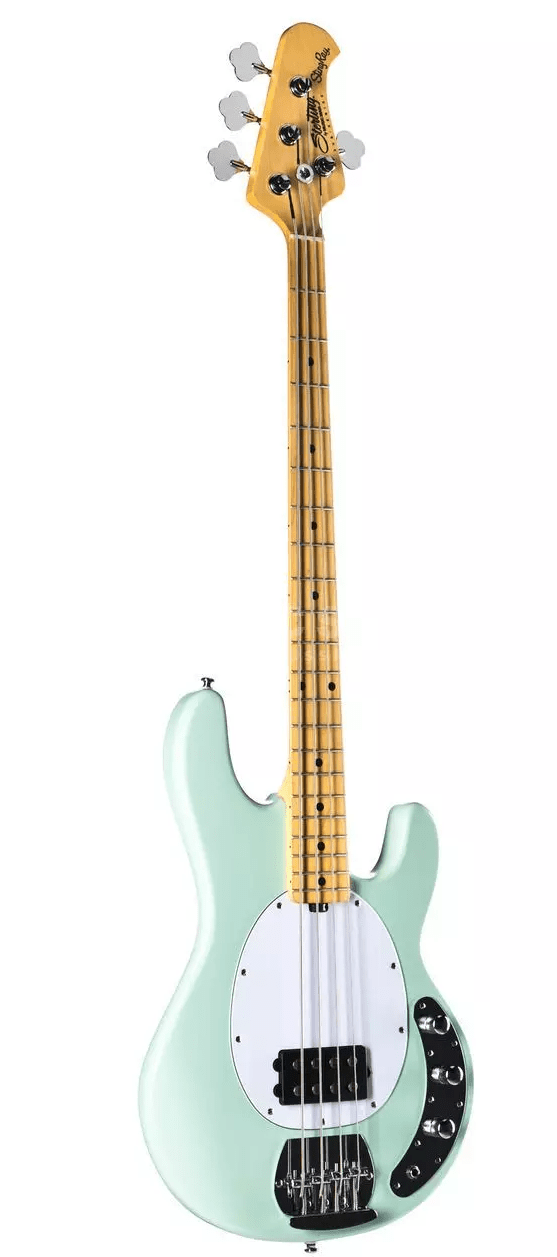
Sterling by Musicman Stingray Ray4 Bass
A slim necked bass that far outperforms its price tag
This bass gives players with smaller hands exactly what they need; an easy to reach fretboard, a comfortable neck, and high end electronics, and does so while keeping costs reasonable.
Gibson has Epiphone, Fender has Squier, and Ernie Ball Musicman has Sterling, which might be one of the best guitar brands you’ve never heard of. The Sterling by Musicman Stingray Ray4 is an extremely well-equipped and well-made instrument that’s absolutely perfect for a player with smaller hands looking to get into bass guitar.
The nut width is extremely narrow for a bass guitar, measuring just 1.5”. Bass guitars usually tend to have pretty beefy necks, but this Stingray Ray4 has slimmed things down, making the entire fretboard accessible for those with small hands.
The specs don’t specifically list the neck profile, but after eyeballing it and spending some time playing it, our assessment is it’s a slim D shape. Regardless of the profile, it felt great in the hand. It played fast and didn’t result in fatigue.
The active humbucking pickup was absolutely fantastic. The tones we got out of this bass were unbelievably fat, something we never expected from a sub-$400 bass. It has huge presence and in a blind test we’d be hard pressed to tell the difference between this model and the US-made version.
The fit and finish were excellent across the board, too. The paintwork was immaculate, tuning stability was great, and the hardware was all very premium-feeling. Body construction is basswood and the model we tested came with a maple neck and maple fretboard.
Verdict: The Sterling by Musicman Stingray is an outstanding choice if you have smaller hands and you’re looking to buy a bass guitar. The neck is fast and the narrow nut and slim profile really make it easy to stretch out across the fretboard. When you consider the overall build quality as well as the sound profile, you’ll realize this might be the most underpriced bass on the market. We suggest you get one before that changes.
How to Choose the Right Guitar For You
When it comes to guitars for players with smaller hands, the main features to look for are largely the same, no matter whether you’re shopping for an acoustic, classical, electric, or bass guitar. In that respect, it’s actually an easy niche to shop for.
Neck Width/Nut Width
If you’ve got smaller hands and you’ve tried playing a guitar that wasn’t designed to cater to your anatomy, you’ve probably been frustrated at how difficult something as simple as a barre chord was to hold. If you shop for guitars with a narrow nut, you’ll find it easier to reach across and depress the strings properly.
Neck Profile
The nut width indicates how broad the neck is, but the neck profile itself has a similarly important impact on playability for guitarists with small hands. Slim C, D, Slim D, and Modern profile necks are usually quite shallow, which will keep your palm closer to the fretboard, ultimately making it easier to reach your fingers around.
Avoid anything with a Vintage neck profile, or anything with a V profile. Both tend to be baseball-bat-like and this can be challenging if you have smaller hands.
Scale Length
Having a shorter scale length can help in 2 ways. First, the shorter scale length means that the distance between frets is less, making it easier for players with smaller hands to reach for chords. Second, a short scale length reduces the string tension, which means less finger strength is required to push down the strings to the fretboard.
Reduced-Size Body
This is especially suitable for children and young players, but it can also be helpful for adults with smaller hands. Even with the ideal nut width and neck shape, a full-sized guitar can be challenging for someone with a smaller build.
The way you hold a guitar affects your fretting hand’s form, and trying to handle an oversized instrument can negatively impact your playing. A smaller guitar can encourage proper form, ultimately enhancing your skills and abilities.
Final Thoughts
Finding the right guitar if you have smaller hands can be understandably challenging. We hope that this guide to the best acoustic, classical, electric, and bass guitars to be useful. To recap, the guitars that we suggest for players with smaller hands are as follows:
For Acoustics, if you’re looking for a great guitar on a tight budget, the Fender Sonoran is the one for you. If you’re happy to spend a bit more and pick up some extra features, the Martin D Jr-10E is all the guitar you’ll ever need.
For classical guitars, we recommend the Epiphone PRO-1 Classic for those trying to keep costs to a minimum. If working with a higher budget, the Ovation Applause AB24CC-4S is a great option.
Budget-conscious electric guitar shoppers should look to the Ibanez Mikro GRGM21, and those looking for something more high end will really enjoy the Fender Player Telecaster.
Finally, if it’s a bass you need, the Sterling by Musicman Stingray Ray4 is one of the most comfortable basses on the market for players with small hands.
Check out these other articles you might like:


